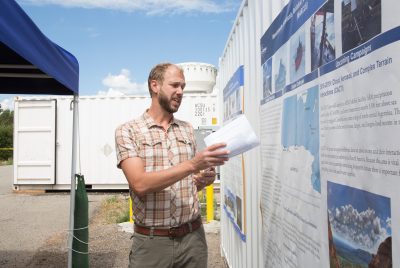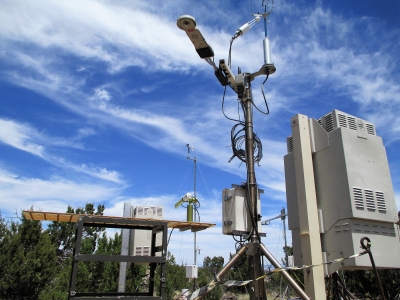Gearing Up for a Stormy CACTI Deployment
Published: 16 June 2018
Editor’s note: Anjeli Doty of the Los Alamos National Laboratory ARM team sent in this update.

Towering stacks of ominous dark clouds, splitting strikes of bright lightning, and torrential rain typify weather in the rugged Sierras de Córdoba mountain range in north-central Argentina. It is a place to find the perfect storm—perfect, that is, to study how mountain ranges influence convective thunderstorm formation, which is exactly what the Cloud, Aerosol, and Complex Terrain Interactions (CACTI) field campaign aims to do.
CACTI, an Atmospheric Radiation Measurement (ARM) user facility field campaign, is set to go from October 1, 2018, to April 30, 2019. The ARM team from Los Alamos National Laboratory (LANL) began preparations for CACTI this spring by beta testing the first ARM Mobile Facility (AMF1), which will house the campaign’s instrumentation. Team members modified instruments to ensure that the devices would be able to withstand the intense weather systems of the Sierras de Córdoba.
After the beta test, the LANL team began packing up AMF1 and the instruments May 21. The items departed for Argentina on June 11, and installation will begin in mid-August.
The Sierras de Córdoba experience some of the largest and longest-lasting storms worldwide. So what makes these storms so ideal to study?
Deconstructing the Perfect Storm
Improving earth system models relies on gathering predictive data in connection with environmental conditions. Understanding storm characteristics—from convective initiation to life cycle evolution—represents a key element of these models, especially as applicable to anticipating and responding to natural disasters and earth system changes.
Storms typically form over complex and expansive terrain, influenced by numerous environmental variables throughout their duration. Such complexity makes isolating specific variables of interest to study a challenge, much like trying to observe the social effect of 10 specific people within a massive crowd, running full speed through a metropolis.
The Sierras de Córdoba provide an optimal study location to observe storm systems. Plateaus surround the mountain range for hundreds of miles, increasing the ability of instruments to measure variables directly contributing to convective storm formation. Because the mountain range is relatively smaller than the towering Andes, which lie 300 miles west, the life cycle of storms and effects of terrain will be uniquely observable from CACTI’s location. Thus, a range of inclement environmental conditions, a high frequency of events, and an isolated mountain range combine to create perfect (researchable) storms.
Reconfiguring Research Equipment, From Island to Mountain

Heath Powers, technical operations manager for the ARM LANL field team, oversaw the CACTI beta test, assisting technicians with reprogramming the equipment and validating readiness for the new deployment. Additionally, ARM technicians and instrument mentors came from all over the world to reconfigure and test equipment before deployment.
The LANL team began the beta test after instrumentation returned from the Layered Atlantic Smoke Interactions with Clouds (LASIC) field campaign on Ascension Island. One of the biggest challenges for CACTI is modifying instruments previously installed in a salty, coastal environment to withstand the subtropical storms of the Sierras de Córdoba. Installing lightning rods to lure bolts away from the main apparatus is one modification example.
CACTI will use several radars, including one that ARM will deploy for the first time in an international mobile facility campaign. The second-generation C-Band Scanning ARM Precipitation Radar (CSAPR2) can observe different types of convective thunderstorms from a long range.
However, radar modification is a time-intensive and technical process that includes designing new scanning strategies and strategizing how to best use the radars to meet scientific objectives.
“Radars are very capable but complex instruments,” says Heath.
Equally complex is the collaboration between the various teams required to successfully set up and install AMF1, including the many radars.
“This community contains people who know how to operate the radars, how to design the data collection strategy for the radars, and how to process and produce a customized, usable data set for the scientific community,” says Heath. “And then there’s us, who transport it all into the country, physically set it up, and operate it.”
The on-site CACTI team will also launch radiosondes (weather balloons) up to four times daily. These radiosondes provide a direct measurement by characterizing the atmosphere out to space, creating a baseline for all the sophisticated instruments on the ground to reference.
“The usefulness of all these other instruments goes way down without the radiosondes,” says Heath.
Goals of CACTI

CACTI’s scientific objective is to research cumulus clouds, specifically how they interact with their surrounding environment and affect storm formation, growth, and organization. The field campaign seeks to answer how:
- elements such as winds, thermodynamics, aerosols, and surface properties affect the life cycles and properties of cumulus clouds, and how these clouds subsequently alter their environment
- these same elements affect storm features, and how these storms subsequently influence their environment
- storms and seasonal precipitation influence soil moisture, surface heat, and atmospheric thermodynamics, and feed back to affect cloud dynamics.
More than 50 instruments will deploy as part of AMF1, and data will continuously be uploaded and available via the ARM Data Center.
Also, ARM’s Gulfstream-159 (G-1) research aircraft will go to Argentina for six weeks during CACTI. The G-1 will be outfitted with 50 instruments to measure aerosol concentrations and optical properties, energy, cloud particle mass and distribution, temperature, pressure, humidity, and wind speed and direction.
The ARM Climate Research Facility is a DOE Office of Science user facility. The ARM Facility is operated by nine DOE national laboratories, including .
Keep up with the Atmospheric Observer
Updates on ARM news, events, and opportunities delivered to your inbox
ARM User Profile
ARM welcomes users from all institutions and nations. A free ARM user account is needed to access ARM data.


















